Fruits and berries have a short, prolific season, which makes them an ideal choice for preserving. In fact, many times, you must do something to preserve them, or all your precious harvest and hard work will go to waste. Fruits & berries can be frozen, dried, or canned. There is no one method that is better than the other; the best preservation option for you depends on what you intend to do with them later.
Frozen berries and fruit are excellent in smoothies, eaten raw, or used in baking or cooking. Dried fruits combine wonderfully with nuts to make homemade trail mixes. The dried fruits are also great for baking or eating as a snack, like with fruit leather. Fruits can be canned whole, sliced, or as a sauce, jam, or jelly. There are so many options!
Berries like blueberries, strawberries, raspberries, and blackberries quickly lose their freshness and juiciness, so it is best to preserve them the same day or soon after you pick them. Pick ripe, plump berries for the best taste and sweetness.
Apples, pears, peaches, plums, and other tree fruits are also best preserved the same day, but they don't lose their freshness as quickly as berries. You can pick them one day and wait a day or two to process them. For the best, ripest flavor, though, preserve them as soon as possible after picking.
Do not wash any fruits or berries until you are ready to process them. Washing removes protective dirt that keeps bacteria and disease away. Once fruits and berries are washed, they begin decomposing quickly!
How To Freeze Fresh Fruits and Berries
Fruits can be frozen cooked or frozen raw. Wash your fresh fruit or berries well to remove any dirt, stems, or withered fruit. Slice fruit or cut it into chunks. Berries can be frozen whole.
To freeze your fruit raw, arrange it in a single layer on a baking or cookie sheet. Put the fruit in the freezer and freeze until hard and firm. Once the fruit is frozen, remove it from the tray and package it into a plastic freezer bag or container. Make sure to label and date the bag.
Adding a bit of sugar to the fruits and berries before freezing also creates an excellent end product. After you have washed and drained the fruits, sprinkle them with sugar. The amount of sugar you use will depend on how much fruit you put away and your preferences. Once the sugar has dissolved completely, put the fruit in freezer bags or freezer-proof containers.
How To Dehydrate Fruits and Berries
Smaller berries can be dried whole in a dehydrator. Large berries, like strawberries, should be sliced in half or quarters. Fruits can be cut up and dried or pureed and spread out onto dehydrator trays to make fruit leather. Dried berries and fruits make excellent snacks and taste great added to granola, cereal, trail mix, and baked goods.
Wash and drain the fruit or berries well. Arrange the fruit on the dehydrator trays, ensuring that they don't touch. If they are touching, it will take much longer for them to dry properly. Follow the directions on your dehydrator for time and temperature settings for fruit and berries. They are finished when they are leathery feeling and have no moisture left. Store dried fruits and berries in air-tight glass jars or plastic storage bags. Glass jars keep them fresh longer.
Both fruits and berries can be canned whole, made into jam or jelly, turned into a syrup, or prepared as pie filling. If you decide to can your berries or fruit, make sure you use a verified recipe and follow the instructions exactly. Canning is a precise method that should not be played around with unless you are a professional. If the process is not followed, your jars of fruit could become contaminated.
Whichever method you choose, the ability to have fruit preserved at the peak of its freshness is well worth the effort.



